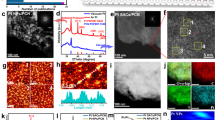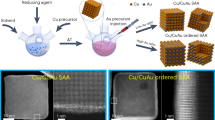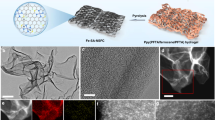Abstract
Single-atom catalysts (SACs) exhibit exceptional intrinsic activity per metal site, but are often limited by low metal loading, which compromises the overall catalytic performance. Pyrolytic strategies commonly used for synthesizing SACs generally suffer from aggregation at high metal loadings. Here we report a universal synthesis approach for ultrahigh-density metal–nitrogen–carbon (UHDM–N–C) SACs via a metal-sulfide-mediated atomization process. We show that our approach is general for transition, rare-earth and noble metals, achieving 17 SACs with metal loadings >20 wt% (including a loading of 26.9 wt% for Cu, 31.2 wt% for Dy and 33.4 wt% for Pt) at 800 °C, as well as high-entropy quinary and vicenary SACs with ultrahigh metal contents. In situ X-ray diffraction and transmission electron microscopy alongside molecular simulations reveals a dynamic nanoparticle-to-single atom transformation process, including thermally driven decomposition of the metal sulfide and the trapping of liberated metal atoms to form thermodynamically stable M–N–C moieties. Our studies indicate that a high N-doping is crucial for achieving ultrahigh-loading metal atoms and a metal-sulfide-mediated process is essential for avoiding metal aggregation at high loadings. As a demonstration, the metal-loading-dependent activity in electrocatalytic oxygen evolution reaction is demonstrated on SACs with increasing Ni content.

This is a preview of subscription content, access via your institution
Access options
Subscribe to this journal
Receive 12 digital issues and online access to articles
118,99 € per year
only 9,92 € per issue
Buy this article
- Purchase on SpringerLink
- Instant access to full article PDF
Prices may be subject to local taxes which are calculated during checkout






Similar content being viewed by others
Data availability
All data are available in the main text or the Supplementary Information. Source data are provided with this paper.
References
Qiao, B. et al. Single-atom catalysis of CO oxidation using Pt1/FeOx. Nat. Chem. 3, 634–641 (2011).
Wang, A., Li, J. & Zhang, T. Heterogeneous single-atom catalysis. Nat. Rev. Chem. 2, 65–81 (2018).
Muravev, V. et al. Size of cerium dioxide support nanocrystals dictates reactivity of highly dispersed palladium catalysts. Science 380, 1174–1179 (2023).
Chang, X. et al. Designing single-site alloy catalysts using a degree-of-isolation descriptor. Nat. Nanotechnol. 18, 611–616 (2023).
Ro, I. et al. Bifunctional hydroformylation on heterogeneous Rh–WOx pair site catalysts. Nature 609, 287–292 (2022).
Lee, B.-H. et al. Supramolecular tuning of supported metal phthalocyanine catalysts for hydrogen peroxide electrosynthesis. Nat. Catal. 6, 234–243 (2023).
Xia, C. et al. General synthesis of single-atom catalysts with high metal loading using graphene quantum dots. Nat. Chem. 13, 887–894 (2021).
Mehmood, A. et al. High loading of single atomic iron sites in Fe–NC oxygen reduction catalysts for proton exchange membrane fuel cells. Nat. Catal. 5, 311–323 (2022).
Zhao, C.-X. et al. A clicking confinement strategy to fabricate transition metal single-atom sites for bifunctional oxygen electrocatalysis. Sci. Adv. 8, eabn5091 (2022).
Iqbal, S., Safdar, B., Hussain, I., Zhang, K. & Chatzichristodoulou, C. Trends and prospects of bulk and single-atom catalysts for the oxygen evolution reaction. Adv. Energy Mater. 13, 2203913 (2023).
Tang, C. et al. Tailoring acidic oxygen reduction selectivity on single-atom catalysts via modification of first and second coordination spheres. J. Am. Chem. Soc. 143, 7819–7827 (2021).
Hai, X. et al. Scalable two-step annealing method for preparing ultra-high-density single-atom catalyst libraries. Nat. Nanotechnol. 17, 174–181 (2022).
Liu, S. et al. Atomically dispersed iron sites with a nitrogen–carbon coating as highly active and durable oxygen reduction catalysts for fuel cells. Nat. Energy 7, 652–663 (2022).
Kuai, L. et al. High-areal density single-atoms/metal oxide nanosheets: a micro-gas blasting synthesis and superior catalytic properties. Angew. Chem. Int. Ed. 61, e202212338 (2022).
Zhao, L. et al. Cascade anchoring strategy for general mass production of high-loading single-atomic metal–nitrogen catalysts. Nat. Commun. 10, 1278 (2019).
Liu, C. et al. Constructing FeN4/graphitic nitrogen atomic interface for high-efficiency electrochemical CO2 reduction over a broad potential window. Chem 7, 1297–1307 (2021).
Zhao, J. et al. Manipulating the oxygen reduction reaction pathway on Pt-coordinated motifs. Nat. Commun. 13, 685 (2022).
Han, L. et al. A single-atom library for guided monometallic and concentration-complex multimetallic designs. Nat. Mater. 21, 681–688 (2022).
Liu, J. et al. Direct observation of metal oxide nanoparticles being transformed into metal single atoms with oxygen-coordinated structure and high-loadings. Angew. Chem. Int. Ed. 60, 15248–15253 (2021).
Chang, J. et al. Oxygen radical coupling on short-range ordered Ru atom arrays enables exceptional activity and stability for acidic water oxidation. J. Am. Chem. Soc. 146, 12958–12968 (2024).
Lei, X. et al. High-entropy single-atom activated carbon catalysts for sustainable oxygen electrocatalysis. Nat. Sustain. 6, 816–826 (2023).
Wu, Z.-Y. et al. Non-iridium-based electrocatalyst for durable acidic oxygen evolution reaction in proton exchange membrane water electrolysis. Nat. Mater. 22, 100–108 (2023).
Jones, J. et al. Thermally stable single-atom platinum-on-ceria catalysts via atom trapping. Science 353, 150–154 (2016).
Nie, L. et al. Activation of surface lattice oxygen in single-atom Pt/CeO2 for low-temperature CO oxidation. Science 358, 1419–1423 (2017).
Qu, Y. et al. Direct transformation of bulk copper into copper single sites via emitting and trapping of atoms. Nat. Catal. 1, 781–786 (2018).
Han, G.-F. et al. Abrading bulk metal into single atoms. Nat. Nanotechnol. 17, 403–407 (2022).
Wei, S. et al. Direct observation of noble metal nanoparticles transforming to thermally stable single atoms. Nat. Nanotechnol. 13, 856–861 (2018).
Li, J. et al. Thermally driven structure and performance evolution of atomically dispersed FeN4 sites for oxygen reduction. Angew. Chem. Int. Ed. 58, 18971–18980 (2019).
Zhao, C. et al. Solid-diffusion synthesis of single-atom catalysts directly from bulk metal for efficient CO2 reduction. Joule 3, 584–594 (2019).
Yang, Z. et al. Directly transforming copper (I) oxide bulk into isolated single-atom copper sites catalyst through gas-transport approach. Nat. Commun. 10, 3734 (2019).
Yang, J. et al. In situ thermal atomization to convert supported nickel nanoparticles into surface-bound nickel single-atom catalysts. Angew. Chem. Int. Ed. 57, 14095–14100 (2018).
Kumar, P. et al. High-density cobalt single-atom catalysts for enhanced oxygen evolution reaction. J. Am. Chem. Soc. 145, 8052–8063 (2023).
Fei, H. et al. General synthesis and definitive structural identification of MN4C4 single-atom catalysts with tunable electrocatalytic activities. Nat. Catal. 1, 63–72 (2018).
Liu, Y. et al. Elemental superdoping of graphene and carbon nanotubes. Nat. Commun. 7, 10921 (2016).
Chang, J. et al. A C-S-C linkage-triggered ultrahigh nitrogen-doped carbon and the identification of active site in triiodide reduction. Angew. Chem. Int. Ed. 60, 3587–3595 (2021).
Dai, L. Graphene: tunable superdoping. Nat. Energy 1, 16041 (2016).
He, X. et al. Building up libraries and production line for single atom catalysts with precursor-atomization strategy. Nat. Commun. 13, 5721 (2022).
Xie, F. et al. A general approach to 3D-printed single-atom catalysts. Nat. Synth. 2, 129–139 (2023).
Wang, B. et al. Room-temperature laser planting of high-loading single-atom catalysts for high-efficiency electrocatalytic hydrogen evolution. J. Am. Chem. Soc. 145, 13788–13795 (2023).
Zheng, Y., Lin, L., Wang, B. & Wang, X. Graphitic carbon nitride polymers toward sustainable photoredox catalysis. Angew. Chem. Int. Ed. 54, 12868–12884 (2015).
Li, W. et al. Exploiting Ru-induced lattice strain in CoRu nanoalloys for robust bifunctional hydrogen production. Angew. Chem. Int. Ed. 60, 3290–3298 (2021).
Song, H. et al. Single atom ruthenium-doped CoP/CDs nanosheets via splicing of carbon-dots for robust hydrogen production. Angew. Chem. Int. Ed. 60, 7234–7244 (2021).
Hohenberg, P. & Kohn, W. Inhomogeneous electron gas. Phys. Rev. 136, B864–B871 (1964).
Kresse, G. & Joubert, D. From ultrasoft pseudopotentials to the projector augmented-wave method. Phys. Rev. B 59, 1758–1775 (1999).
Zhang, Y. & Yang, W. Comment on ‘Generalized gradient approximation made simple’. Phys. Rev. Lett. 80, 890–890 (1998).
Blöchl, P. E. Projector augmented-wave method. Phys. Rev. B 50, 17953–17979 (1994).
Qu, Y. et al. Thermal emitting strategy to synthesize atomically dispersed Pt metal sites from bulk Pt metal. J. Am. Chem.Soc. 141, 4505–4509 (2019).
Yang, H. B. et al. Atomically dispersed Ni(I) as the active site for electrochemical CO2 reduction. Nat. Ener. 3, 140–147 (2018).
Acknowledgements
This work was partly supported by the National Natural Science Foundation of China (NSFC, nos. 52122308 52202050, 21905253 and 51973200), the China Postdoctoral Science Foundation (2022TQ0286), the Natural Science Foundation of Henan (202300410372) and the Joint Fund of Science and Technology R&D Plan of Henan Province (232301420042). We also acknowledge the Beijing Synchrotron Radiation Facility and the Center for Modern Analysis and Gene Sequencing of Zhengzhou University for supporting this research. G.I.N.W. acknowledges funding support from the Ministry of Business Innovation and Employment (C05X2007 and UOCX2118) and the Royal Society Te Apārangi (James Cook Research Fellowship). X.Y. acknowledges the Leverhulme Trust for Early Career Fellowship for support.
Author information
Authors and Affiliations
Contributions
S.L., X.D., B.Y., Z.T. and J.C. designed and coordinated the project and also supervised all aspects of the research. W.J. conducted the materials synthesis, structural characterizations of the prepared catalysts and electrochemical measurements, interpreted the data and drafted the paper. X.Y., A.C. and J.Y. carried out the corresponding DFT calculations. S.W. assisted with the in situ experimental investigations. Data collection and analyses were performed by W.J., H.W., C.W. and S.W. G.I.N.W. participated in discussions about the experimental results and providing valuable suggestions for the research. All authors contributed to the preparation and editing of the paper.
Corresponding authors
Ethics declarations
Competing interests
The authors declare no competing interests.
Peer review
Peer review information
Nature Synthesis thanks Christodoulos Chatzichristodoulou, Yuen Wu and the other, anonymous, reviewer(s) for their contribution to the peer review of this work. Primary Handling Editor: Alexandra Groves, in collaboration with the Nature Synthesis team.
Additional information
Publisher’s note Springer Nature remains neutral with regard to jurisdictional claims in published maps and institutional affiliations.
Supplementary information
Supplementary Information
Supplementary Figs. 1–81, Discussion, Notes 1–7 and Tables 1–5.
Supplementary Video 1
A movie shows the dynamic decomposition process of the Ni3S3 nanoparticle.
Supplementary Video 2
A movie shows the dynamic decomposition process of the Ni8S8 nanoparticle.
Supplementary Video 3
A movie shows the dynamic atomization evolution by theoretical simulation, where the emitted Ni atom is trapped by the N-dopants to form a thermodynamically stable Ni−N4−C site.
Source data
Source Data Fig. 2
Statistical source data for Fig. 2
Source Data Fig. 3
Statistical source data for Fig. 3
Source Data Fig. 5
Statistical source data for Fig. 5
Source Data Fig. 6
Statistical source data for Fig. 6
Rights and permissions
Springer Nature or its licensor (e.g. a society or other partner) holds exclusive rights to this article under a publishing agreement with the author(s) or other rightsholder(s); author self-archiving of the accepted manuscript version of this article is solely governed by the terms of such publishing agreement and applicable law.
About this article
Cite this article
Chang, J., Jing, W., Yong, X. et al. Synthesis of ultrahigh-metal-density single-atom catalysts via metal sulfide-mediated atomic trapping. Nat. Synth 3, 1427–1438 (2024). https://doi.org/10.1038/s44160-024-00607-4
Received:
Accepted:
Published:
Issue Date:
DOI: https://doi.org/10.1038/s44160-024-00607-4
This article is cited by
-
Engineering high-density microcrystalline boundary with V-doped RuO2 for high-performance oxygen evolution in acid
Nature Communications (2025)
-
Atomically engineered interfaces inducing bridging oxygen-mediated deprotonation for enhanced oxygen evolution in acidic conditions
Nature Communications (2024)



